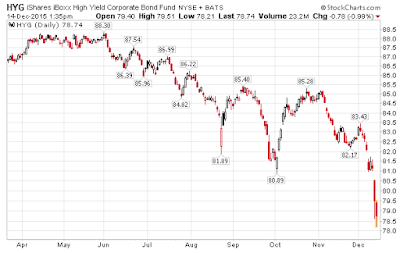In financial markets rot starts at the periphery and spreads to the core. For weeks, rot has been visible in the junk bond market and that rot has deepened sharply recently.
JNK – Barclays High Yield ETF
HYG – iShares iBOXX High Yield Corporate Bond Fund
Liquidity Trap
A potentially destabilizing run on junk debt has weighed on the bond markets. Investors in one fund are totally locked out of redemptions. And effective yields have soared.
Please consider The Liquidity Trap That’s Spooking Bond Funds.
The debt world is haunted by a specter—of a destabilizing run on markets.
Last week, this took on more form even if there weren’t concrete signs of panic. Only one mutual fund manager, Third Avenue Management, has said it would halt redemptions to forestall having to dispose of assets in a fire sale. The rest of the industry has been quick to say that while redemptions are elevated, particularly in high-yield bond funds, there doesn’t seem to be a rush to for the exits.
Goldman Sachs, for one, put out a note Friday warning Franklin Resources “is most at risk” given the large high-yield holdings of its funds, poor performance and large outflows. On Friday, its shares fell sharply. Meanwhile, there were unusually large declines Friday in the value of exchange-traded funds that track high-yield debt.
The idea of a “run” on mutual funds might sound strange. Typically, runs are associated with highly leveraged banks engaged in maturity transformation, funding long-term loans with short-term debt. Nearly all the programs designed to avoid destabilizing runs—from deposit insurance to the Fed’s discount window to liquidity requirements—are built for banks.
But unleveraged investors, including mutual funds, can also give rise to runs. That is because there is a liquidity mismatch in mutual funds that hold relatively illiquid assets funded by investors entitled to daily redemptions.
Similar to what can happen in a bank run, investors in open-end funds holding relatively illiquid assets have an incentive to withdraw early to avoid being last out the door.
The problem is potentially more acute when it comes to funds that invest in corporate bonds, which don’t trade frequently, as opposed to stocks. That is an even greater concern today given questions about bond-market liquidity.
Mutual-fund fragility was highlighted in a speech last year by then-Fed Governor Jeremy Stein and a related paper prepared for a Fed policy forum. Mr. Stein noted fund managers were likely to sell more-liquid holdings to meet the earliest redemptions. This leaves remaining investors even more exposed to illiquid bonds.
Panic Early
The message here is clear. If you are going to sell be the first. In short, panic before anyone else does.
That advice is especially important for junk bond ETF holders as managers tend to sell liquid issues first, presumably holding the most illiquid and likely junkiest of junk on the books.
High Anxiety
Why Now?
It is absurd that CCC-rated debt, right on the verge of default would ever yield as little as it did. In regards to that point, I have noted the bubble in junk bonds numerous times over the past couple years.
Why this took so long to sink is anyone’s guess, but undoubtedly the FED’s QE played a part.
And bubbles nearly always go on longer than one might think.
But here we are. And here’s another important point, equity selloff frequently begin with bond market dislocations or deteriorating equity-market breadth.
Be forewarned. Today we see both. And at a time the stock market is more overvalued than ever.
Further Reading
- “War Games” Show Fed Worried About Commercial Real Estate, Interest Rates; Fed Weighs Consequences of “Macroprudential Tools”
- Stocks More Overvalued Now Than 2000 and 2007 No Matter How You Look at Things
In regards to point one, the Fed after warning about “Macroprudential Tools”, does not even realize QE and interest rate policy are the bluntest of blunt instruments, both prone to bubble-blowing episodes. Once bubbles get big enough, those tools no longer work. And the opposite tool (in this case ending QE and hiking rates) might have an over-seized effect.
In regards to point two, Fed timing could hardly be worse, but the only alternative is even bigger bubbles that would pop on their own accord anyway.
Mike “Mish” Shedlock


